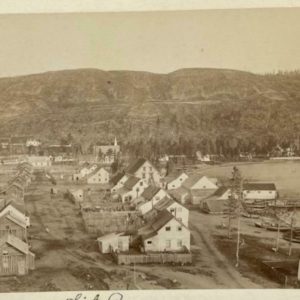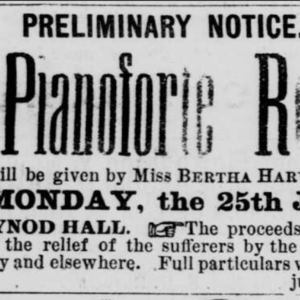 If you’re a descendant of John Joy (1842-1923) I’ve got some bad news for you. I think your ancestor may have killed four people. On December 8th of 1888 he appeared in Little Bay’s Courthouse to answer for starting a brush fire on June 6th which raged beyond control. It was found to have been started in his garden but they were unable to prove that it was he who’d lit it. The blame never fell elsewhere and he remains our prime suspect.
If you’re a descendant of John Joy (1842-1923) I’ve got some bad news for you. I think your ancestor may have killed four people. On December 8th of 1888 he appeared in Little Bay’s Courthouse to answer for starting a brush fire on June 6th which raged beyond control. It was found to have been started in his garden but they were unable to prove that it was he who’d lit it. The blame never fell elsewhere and he remains our prime suspect.
Newfoundland was struck by disastrous fires in the summer of ’88. The first international coverage appears in the New York Times on June 8th in a press release that circulates as far as India. Two things are clear from that coverage; there were a lot of fires on the island that summer and Little Bay experienced the worst of it.
The first thing I wanted to do was understand the circumstances of that summer. Weather reported in St. John’s indicated a dry season. It’s difficult to get information on weather that far back outside of the city but lucky for us, Little Bay’s Paymaster kept excellent records. Transcribing his journals I found a similar phenomena affecting our Northern Mining Region. He describes the weeks leading up to the fire as fair and reports very little in precipitation.
June 6th, like the summer days that preceeded it, was dry and warm. Early in the afternoon of that day the fire started. It was first spotted by Thomas Sexton at 3pm. It appeared only as a puff of blue smoke in the distance but fortunate for all involved the spotter had experienced such before. At once, as was the practice, he began hauling his furniture out from his home. Others followed suit dragging beds and cabinets outside and tossing them into the little brooks nearby. In previous fires, when there’d been more time, they’d quickly buried their valuables in miner’s fashion but on this occasion there was no time. Before they could retrieve a second load from their houses an inferno was upon them. It wasn’t five minutes from the first sign of smoke before they faced a wall of flame nearly a kilometre of width. Smoke preceeded it engulfing townsfolk composed mostly of women and children. The men were at work underground and unaware of the spectacle above their heads. Up there existed a nightmare. Children were screaming for mothers lost in the smoke.
The first to be overtaken was William Richards who had been hauling timber. He dropped the load and leapt onto his horse. Blinded by smoke and ash he pushed the animal to top speed toward safety. The animal fell before James Stamp’s place. Mrs. Stamp was inside. As the embers landed on her roof she turned to her husband and remarked “it must be raining.” Her husband, realizing what the sound really was, dragged her out the door. Mrs. McCarthy carried her three children to safety. With one on her back and one in each of her arms she walked a full kilometre through the thickest of smoke. Mrs. Manning and Mrs. Carpenter were less quick and stayed saving their supplies for too long. Pat Carpenter saved his mother and brother. Their clothes were on fire as he dragged them to safety. Kitty Manning was not so lucky. A fit and active woman of 42 years she overestimated herself on that day. She paid the price for that mistake with her life and the lives of her two remaining children. Those three were found together in the aftermath. She’d lost her other five children the previous year to a diphtheria outbreak. Her husband was away from town this day. He would return to nothing at all.
By the grace of luck or gods the wind changed suddenly before the blaze fell upon the main settlement in The Bight. It was almost to the cricket field by then. In less than an hour 27 homes were taken from a newly established area of Little Bay known as The Valley where it was said the homes were just starting to look nice and many had begun planting flowers outside. That was all gone now. Only ash remained.
When count was taken the next day Little Bay found their number reduced by four. The Mannings and one other. John Driscoll was missing. A search was conducted and his body was found lying by a brook near Stamp’s garden. They brought his remains to the hospital to join the others. Little Bay could do nothing but rebuild – rebuild and grieve.
 The town was at the peak of its importance at this time and media covering the event circulated quick and wide. Relief efforts were underway in St. John’s by June 8th for the 200 people left destitute. Many were injured and the town suffered losses of both property and crops. Governor Blake held a meeting in the Athenaeum on the 13th with much attendance. Money was raised and goods were donated to help those suffering. Miss Bertha Harvey held a pianoforte recital at Synod Hall on the 25th to raise more funds. Vocals were added by Miss Fisher and Rev. Dunfield with Mr. Rennie on the violin. Children from St. John’s performed Romberg’s Toy Symphony. In Harbour Grace they’d raised over one thousand dollars by June 20th.
The town was at the peak of its importance at this time and media covering the event circulated quick and wide. Relief efforts were underway in St. John’s by June 8th for the 200 people left destitute. Many were injured and the town suffered losses of both property and crops. Governor Blake held a meeting in the Athenaeum on the 13th with much attendance. Money was raised and goods were donated to help those suffering. Miss Bertha Harvey held a pianoforte recital at Synod Hall on the 25th to raise more funds. Vocals were added by Miss Fisher and Rev. Dunfield with Mr. Rennie on the violin. Children from St. John’s performed Romberg’s Toy Symphony. In Harbour Grace they’d raised over one thousand dollars by June 20th.
Father O’Flynn conducted a memorial service for the fallen at Her Lady of Carmel Parish on the 9th of June which was said to be somber and impacting. At a meeting on the 12th of June a committee was formed to collect funds for fire relief locally which consisted of Mr. Stewart, Keating, Spinney, McKinnon, Deloughery, and Berteau.
Governor Blake planned a visit to Little Bay in the aftermath. He was expected to arrive on the 6th of August. It was for that day that events were planned. All work was stopped for celebration. Flags were raised and Little Bay held a day of festivities to contrast previous events. It was unfortunate therefore when the Governor arrived a day late. He showed up on the morning of the 7th aboard the man-of-war HMS Pylades and was greeted on the wharf by Magistrate Blandford and Mine Manager Whyte. He was recieved with deep gratitude for all that he and the city of St. John’s had done for Little Bay during its hour of need.
Little Bay, the unofficial capitol of the mining region, did not forget its debt to St. John’s, the official capitol of the colony. St. John’s would face its own devastating fire in the year of 1892. The Harbour Grace Standard reported that Little Bay was immediate to the front with fire relief calling forth a committee to meet the calamity head-on before details of the event were even known.
Newfoundlanders then, as today, show such kindness. I’m reminded of what Mr. Rodger’s taught us to do when bad things happen – look for the helpers.
Thank you for reading. I know many have reached out with requests that I cover certain families or topics. I appreciate your patience. I have a lot to cover. Just covering this one day in 1888 required dozens of sources and some transcription. I had to resist found sources on other topics – yesterday I found two on the Diver Dobbin solving a mass murder and one of him seeing a ghost while treasure hunting! I also have lots planned such as transcribing government letters at The Rooms and the Voter’s List which is in Twillingate. I am at this work for hours daily as I have been for years now but there is still so much to do. If you’d like to help you can donate here and if donation is too much to ask it’s also super helpful to follow the Facebook page and share this post from there as that’s often how I find new original sources and pictures. Some items I’d love to find for this piece are Mr. Manning’s first name, a picture of John Joy, the court records pertaining to this fire, and finally any original writings that remain of these events as recounted by Governor Blake. Special thanks again go to Milt Anstey for filling in some of the first names for those mentioned.
The full list of houses lost in Little Bay’s 1888 fire are listed below:
- Samuel Byrne
- John Osmond
- Patrick Shelley
- Edward Shelley
- William Cantwell
- John Richards
- John Connors
- James Stamp
- Thomas Joy
- James Driver
- William Hartry
- Mrs. Lewis
- John Walsh
- Phillip Conway
- Edward McCarthy
- John Ford
- David McAllister
- James McAllister
- Frank Conners
- David Dobbin
- Jospeh Seivards
- Alice Glavine
- John Edwards
- The Mannings
- The Carpenters
- Thomas Connors
- Michael Bazine
- Thomas Read
- William Hayes
- Thomas Sexton
Sources (by topic):
Fire:
- All Quiet – Wells
- In Deep Water – Perry
- Lind ledger
- Moments in Time – this source mixes up the names of Manning and Driscoll.
- Colonial Commerce
- ET (June 8)
- HGS (June 9)
- HGS (June 13)
- DC (June 19)
- TS (June 23)
- NYT (June 8)
- BWG (June 13)
- C&INP (June 23)
Relief efforts:
- TS (July 5)
- TS (Oct 27)
- ET (June 9)
- ET (June 15)
- ET (June 16)
- ET (July 14)
- DC (June 14)
- DC (June 15)
- DC (June 23)
- HGS (June 20)
Blake visit:
- TS (Aug 11)
- TS (Aug 18)
St. John’s fire relief:
- HGS (Aug 2, 1892)
